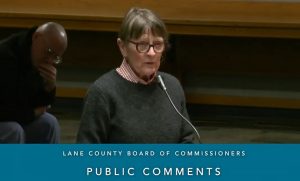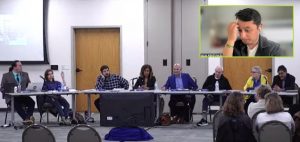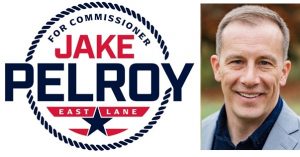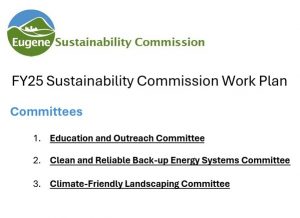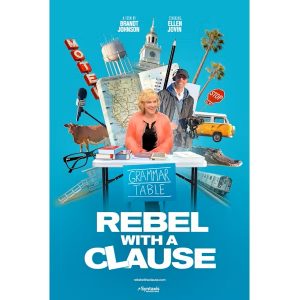Council hears that LTD is making land use decisions
4 min read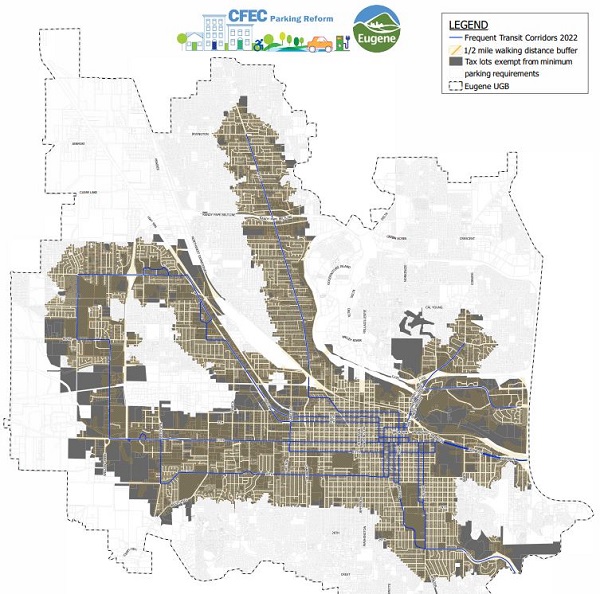
LTD has quietly been making land use decisions. The Eugene City Council hears May 22 that new state rules about off-street parking are based on the bus schedule.
[00:00:12] Councilor Matt Keating: I have a question about the definition of ‘transit corridor.’ And I recall during the HB 2001 (missing middle housing) implementation conversation within this last year, Council voted to provide incentives for off-street parking if you were a half-mile from an EmX stop, not necessarily a half-mile from an LTD stop.
[00:00:38] Jeff Gepper (City of Eugene): Hi Councilor, this is Jeff Gepper, senior planner with the Planning Division. So, ‘frequent transit corridor’ as defined by the Climate Friendly and Equitable Communities rules, kind of put in a nutshell, is essentially a quarter-mile distance from an area that receives at least four transit service stops per hour. And those are along the lines, not the stops themselves.
[00:00:59] John Q: For example, Routes 51 and 52 each come twice an hour. Where those routes overlap there are four scheduled stops per hour, and it’s a frequent transit corridor.
[00:01:10] Jeff Gepper (City of Eugene): And so staff made the call to be consistent with the way that you previously had identified during the middle housing process to use walking distance as opposed to just as-the-crow-flies distance from those transit lines. So, those areas that are within a quarter-mile of a walking distance of a frequent transit corridor, that’s what we’re talking about.
[00:01:28] Councilor Matt Keating: Who, does LTD provide that map? Does that map exist? Is it public-facing? I appreciate the elimination of the ‘as the crow flies’ and the commonsense piece about the walkable piece. But you start getting into the South Hills, there are some homes in the hills that are within that quarter-mile distance that aren’t necessarily as walkable.
[00:01:48] I’m just saddened that we’ve made a clear distinction at one point, and there seems to be little to no authority in the very vote that we took to ensure that there wouldn’t be such congestion or off-street parking incentives in communities that couldn’t handle it.
[00:02:10] Councilor Alan Zelenka: We passed an ordinance that has a quarter-mile from a station during the ‘missing middle’ housing code amendments. And then now CFEC is coming into play, which changes it to a half mile from the line. I’m wondering if that supersedes our ‘missing middle’ housing code vote that we took.
[00:02:28] Jeff Gepper (City of Eugene): Thanks, Councilor Zelenka, this is Jeff Gepper again. So just wanted to let you know that yes, the Climate Friendly and Equitable—it doesn’t necessarily override, that’s a legal question as to how those interact. However, we are not allowed to apply those parking requirements within the zoning code for those areas that are identified in the frequent transit corridors under the Climate Friendly and Equitable Communities rules. So as such, it does effectively override.
[00:02:55] Councilor Alan Zelenka: Yeah, that’s what I thought. On the grander scheme of things, I agree that the missing middle housing, HB 2001, which is a cookie-cutter solution, that wasn’t very strategic. It was a Portland-centric solution, and more density without parking causes livability problems.
[00:03:17] Councilor Greg Evans: Four years ago when I was president of the League of Oregon Cities, we vigorously opposed House Bill 2001 for these reasons, because it was not well thought out. And now we’re going to have to figure out how to go back and fix this so that we don’t have people living on top of each other and not able to move, and not able to get where they need to get, in order to go to school, to work, everything else.
[00:03:49] To answer Councilor Keating’s question about transit corridors: Yes, there is a map. LTD does have a map. When I was on the LTD board for seven years, that’s what we talked about was: How can we build better transportation on heavily-traveled transit corridors throughout our community—which West 18th is one of those corridors, which has multiple LTD lines using that corridor for transportation.
[00:04:22] So, as we look at the whole picture—transportation, parking, livability—there are things that we’re going to have to fix and I’m not sure that we have the toolbox to fix because our hands have been tied by the legislature. So I’m hoping that there may be some way that we can have a retake and look at House Bill 2001 and fix the flaws that are in it.
[00:04:50] We do need affordable housing but I am very much afraid of what this might mean as we’ve moved further down the road with more proposals and we start piling people on top of each other.
[00:05:06] I don’t know about the rest of you, but I grew up in a big city. I know what a ghetto is. I grew up in one. So, you know, when you start piling people on top of each other, you’re going to get really ugly results. And that’s something that I think that we need to avoid in this community like the plague.
[00:05:26] John Q: Like Routes 51 and 52 on River Road, Routes 33, 73, and 24 created frequent transit corridors in South Eugene. Route 73 was discontinued without asking the public. As the city council heard Monday, under CFEC, LTD effectively changed land use.
